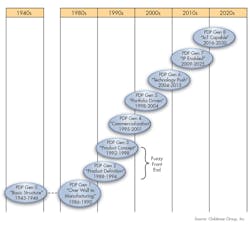Design Thinking for IoT in the Product Development Process
This file type includes high resolution graphics and schematics when applicable.
Product development processes were not a big deal until 1983, when several noteworthy articles outlined the merits of competing based on a best practices product development process. In 1986, Robert Cooper trademarked the Stage-Gate process, thus sparking the industry wave. Like all bodies of knowledge, time brings evolution and maturation. Some bodies take six decades to fully mature, which is also true for development processes. The surprisingly rapid arrival of the Internet of Things (IoT) and Industrial Internet of Things (IIoT) between 2015 and 2020 necessitates another incarnation of the product development process.
Since Cooper lit the torch with a basic process construct that started at approval and ended at launch, elegance has been added. The early 1990s brought in a product definition phase which was preceded by a concepting activity. The late 1990s saw improvements for technology-push products, rapid commercialization, and the formalization of portfolios at every phase of the pipeline.
The early 2000s ushered-in advanced development processes and innovation skunk-works organizations which were separated from product development and added refinements for technology-push. The late 2000s integrated intellectual property (IP) to generate, protect, and monetize it through licensing and sale. In the early 2010s, we made it lean. Many are still working on IP and lean. But—never a dull moment—the IoT is arriving faster than many had imagined.
Currently, few companies have gone through their product development process from stem to stern to prepare for the IoT. Modifying business and technical processes, and using them until they become the norm, takes several years. IP is a great example of this. There is urgency, however. If predictions that there will be hundreds of billions of connected devices by 2025 are true, it would stand to reason that the companies that design "IoT-ready" products would have an advantage.
What then are the implications of IoT-ready products on the product development process? Let's use a bit of design thinking to look for places to tailor the product development process for the IoT. Right now, the value of the product is largely about the product itself. In the future, the value of the product will also be its information content and its ability to aggregate vertically and horizontally in the cloud. A well-designed process can go a long way to enabling "IoT capability." My previous column discussed the importance of sensors. The better the source data and the less it costs, the better the resultant value. That is a good starting point.
One of the first considerations for a new product is its portfolio fit. Does the product fit with the company's IoT goals for the portfolio, product line, or family? Has the company established IoT goals at these levels yet? From a technical view, do architectural rules and guidelines exist for incorporating sensors, wireless, flash, and other possible "IoT enablers" in a systematic way?
For project plans and approval decisions, do business plans address "IoT ability" in a consistent manner as is done for other variables that have become part of every business plan? Are there implications for bills of material, design reviews, and other structural and checklist documentation? Chip and PCB designers have been provisioning for magnetic fields, cross talk, and current surges at the micro level. In the future, fully connected products touting 100% up-time will have many of these same design considerations at the macro level—and associated safety issues.
Alpha and beta testing with customers and focus groups is sure to bring in a whole host of new types of inputs, slowing down products that are well along in development. As one nears product launch, technical literature and marketing promotional materials will have to address IoT capabilities in a consistent way. My guess is that many companies will soon develop an "IoT branding" strategy. These branding strategies will mature with time, ultimately emanating from architectural principles early-on in the process, as enabling the IoT also approaches its own day-to-day norm with product developers.
The IoT will be no different than other product development process improvements. They all had their "what does it all mean?" beginning. Companies that eagerly addressed early-market uncertainties were the first to become proficient. Other companies then copied their practices. But, the eager ones got a three- to five-year head start.
This file type includes high resolution graphics and schematics when applicable.
About the Author
Bradford Goldense
Contributing Technical Expert
Bradford L. Goldense is founder and president of Goldense Group, Inc. [GGI] (www.goldensegroupinc.com), a consulting, market research, and education firm focused on business and technology management strategies and practices for product creation, development, and commercialization. He has been an adjunct faculty member of the graduate engineering school at Tufts University's Gordon Institute for 19 years. Goldense is a Certified New Product Development Professional [NPDP], a Certified Manufacturing Engineer [CMfgE], a Certified Computer Professional [CCP], and is Certified In Production & Inventory Management [CPIM]. He holds over 200 registered copyrights and is a recognized subject-matter expert, including appearances on PBS and CNBC. He has consulted to over 250 companies and over 750 manufacturing locations on four continents since founding GGI in 1986. Goldense holds an MBA in Accounting from the Cornell Johnson School and a BSCE from Brown University. For more information, please see Brad's LinkedIn profile or visit GGI's home page.



